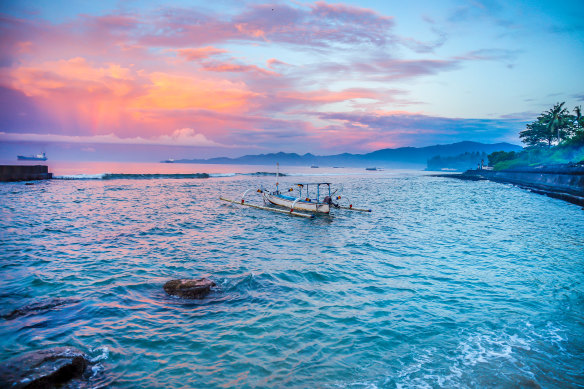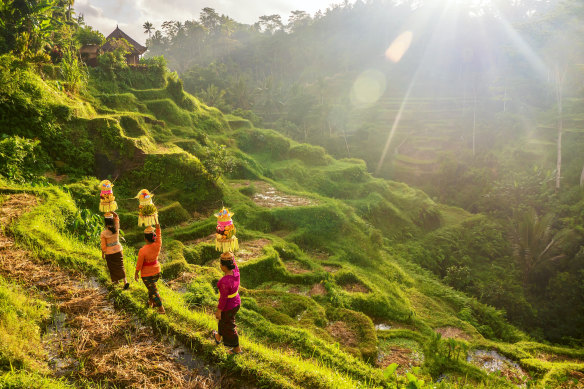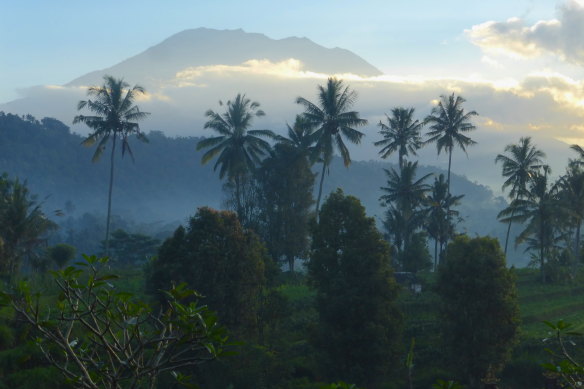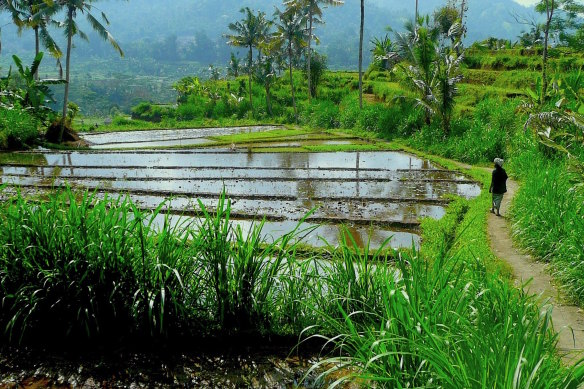The ‘other’ Bali still exists, and it’s only an hour from the airport
In the tiny fishing village of Tulamben, on Bali’s east coast, I meet an Aussie expat who’s lived too long away from home to mix his words.
“All these Aussies complaining about Bali not being like it was 30 years ago,” he says. “And they live in Canggu or Seminyak. Or they holiday in the same places they did in 1995, like Kuta. Bali is like it was 30 years ago, you just have to look for Bali a bit harder these days.”

Sunrise in Candidasa.Credit: iStock
He’s not talking about far-flung destinations reachable only by 4WD or boat either. Tulamben is as far removed from Bali’s overcrowded south-western coast as you’ll ever need venture, yet it’s barely three hours’ drive from Seminyak. Bali’s overlooked east coast actually begins around the coastal village of Candidasa, an hour’s drive from the international airport. So close, but so very far.
He’s scolding me as much as anyone. I’ve been coming to Bali for 30 years, and the traffic jams and pollution around my favourite haunts concerned me so much on my last visit I haven’t been back for a decade. This time around, I’m turning my back on the places I once loved.
I drive instead to Candidasa, finding a pretty coastal village with enough hotels, restaurants and cafes to provide buzz with none of the traffic chaos of the south. But it’s beyond Candidasa – where the coastline sweeps north, and the hinterland turns mountainous – that I suddenly return to a Bali I first met in 1992.

Balinese women in traditional dress, rice paddies … the real Bali.Credit: iStock
I wind my way round hairpin corners where locals bathe and wash clothes in rivers and women sell fruit centimetres from the roadway. Rice terraces tended by farmers with water buffalo spill down hillsides, two cars can barely pass and sometimes there’s hardly room for just mine.
Up higher, I look across a misty green valley to Mount Agung, the 3142-metre active volcano which dominates the landscape. Its most serious eruption was in 1963 and the huge piles of lava left behind made much of the land difficult for farming, forcing entire communities to flee to other parts of Bali, like Kuta. That’s why East Bali is still sparsely populated.

The still-active Mount Agung.
I could drive for days through this reverie, past tiny temples by the roadside, through communities removed from the modernity of the “other” Bali. But there’s plenty more to do.
The region’s black sand beaches (there are some spectacular anomalies if you know where to look) keep the crowds away – oh, and the fact there’s barely a single bar or restaurant on any of them. But the region offers Bali’s best diving and snorkelling options as well as surf spots no one knows about. I drive further north along the coast, where fishermen gather in groups beside their boats to eat noodles after mornings at sea, and to beach towns where divers hang out.

East Bali offers a window into traditional Bali.
Amed is the best known of them – yoga retreats and bars with live music on the beach here give it a black-sanded, retro-Byron kind of vibe. There are enough luxury accommodation options and Western-style restaurants here to keep everyone happy, but I like that it takes five minutes of driving to escape entirely into a more traditional version of Bali, where you can eat barbecued fish at warungs beside the beach that cost a tenth of what you’ll pay for a green smoothie in Canggu.
Some of Bali’s most sacred temples can be found nearby, but I’m anxious to avoid anywhere busloads of tourists might stop. In towns like Amed and Candidasa I’m still offered boat trips, massages and taxis as I walk the streets, but a polite “no” stops the spruiking – something you sure won’t find on the south coast.
In Bali’s most popular tourist areas, it’s impossible to gain any insight at all into normal daily life, but just driving here is a cultural activity in itself. I spend three days in the area; and when I do return to the places I knew long ago, at least I know I’ll have an exit strategy if the chaos gets too much.
The details
Fly
Jetstar (jetstar.com.au), Virgin Australia (virginaustralia.com.au) and Qantas (qantas.com.au) fly to Bali daily from Sydney and Melbourne, rent a car at the airport with Avis avis.com.au
Stay
Sleep in a room overlooking the ocean at Amed from $150 a night, bluemoonvillas.com; base yourself in Candidasa at a resort with rooms overlooking the beach from $165 a night candibeachbali.com; or go where fewer tourists go to Tulamben from $190 a night, relaxbali.cz/en/.
More
The writer travelled at his own expense.
Sign up for the Traveller Deals newsletter
Get exclusive travel deals delivered straight to your inbox. Sign up now.